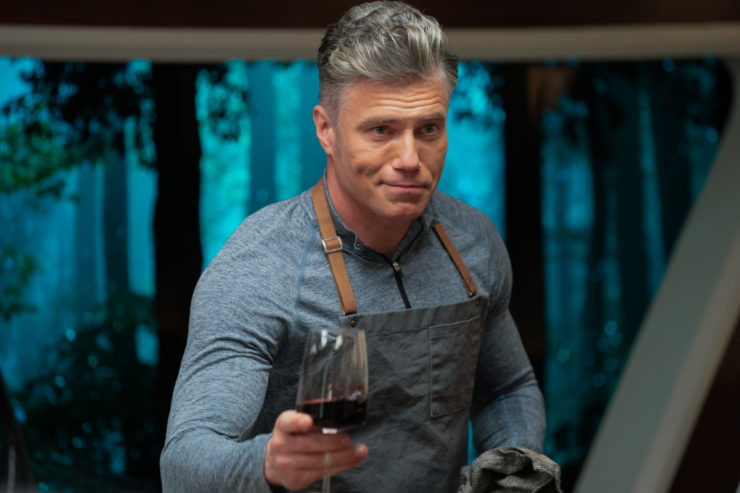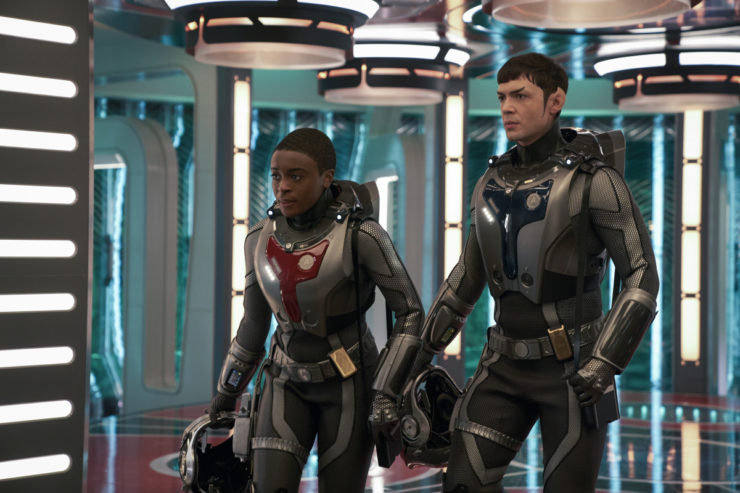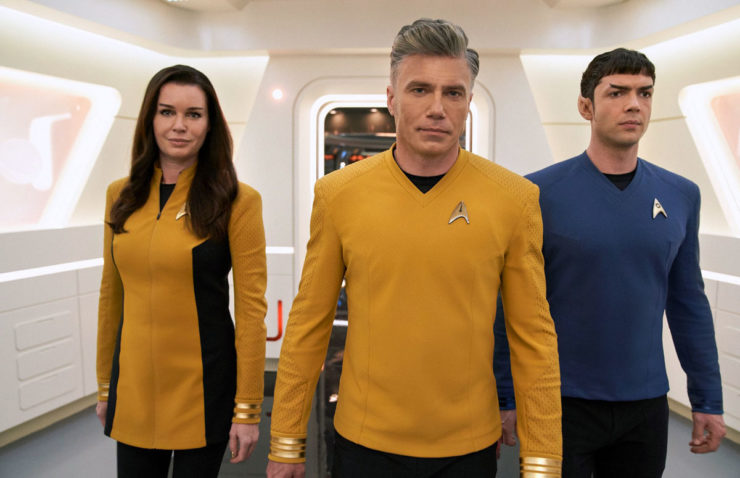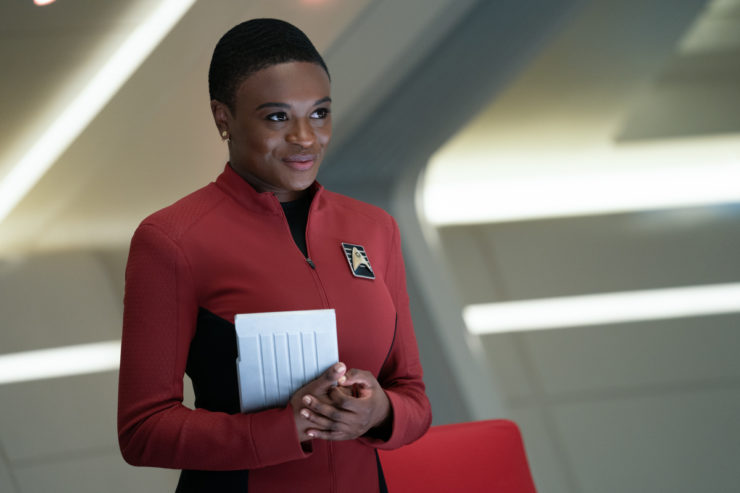Nichelle Nichols famously was planning to quit the role of Lieutenant Uhura after the first season of the original Star Trek in order to take a role in a Broadway show. At an NAACP dinner, she was introduced to a big fan of the show, who turned out to be Dr. Martin Luther King Jr., who said Star Trek was the only show he and his wife let their kids stay up late to watch. Dr. King convinced Nichols to stay in the role because it was so important to see a person of color working an ordinary, prominent job, not because she was black, but because she was a person.
And yet despite that importance, because of the realities of being a supporting character in a 1960s TV show, we learned more about the character of Uhura before the opening credits of this week’s Strange New Worlds than we did in all of the character’s prior fifty-six-year screen history…
As I said last week, the inclusion of Cadet Uhura in the cast of SNW gave me pause, but after two episodes of Celia Rose Gooding in the role, I’ve released the pause button. She is superb in the role, magnificently channeling Nichols while very much giving us her own spin as a younger version of the character, one who’s much less sure of herself.
For starters, the producers of SNW have done something that wasn’t done fifty-six years ago, but was done in a lot of Trek tie-ins, in the Bad Robot movies with Zoë Saldana’s iteration of Uhura, and also with Hoshi Sato on Enterprise, which is acknowledging that the communications officer on a starship would need to have a facility with languages. In a very nice touch, Uhura explains that this grew out of the large number of languages spoken in her native Kenya alone, and as a girl, she decided that she wanted to be able to talk to everyone in their native tongue, so she learned, basically, all of them.

This comes out during a dinner in the captain’s quarters that opens the episode, which is a lovely scene, and one that fits in beautifully with the Christopher Pike who introduced himself to the Discovery crew in “Brother” by asking for a roll call of names without ranks because “they don’t matter.” The captain’s mess is a mix of senior officers and lower-ranking types (“regular people,” as Ortegas puts it). Uhura attends in her dress uniform, because Ortegas hazes her—everyone else is in either casual clothes or their regular uniform—and when Pike asks her where she sees herself in ten years, she surprises everyone by saying she’s not sure. She only joined Starfleet because her pursuit of an academic career was sidelined by a shuttle accident that killed her parents (both professors at the college she was about to attend) and her brother, which made attending university much less appealing. Her grandmother, who she went to live with, was Starfleet, so she’s trying that. “So you ran away to Starfleet,” Pike says in a tone that very much sounds like, “You ran away to the circus,” and the rest of the episode is Uhura coming to terms with her indecision about what to do with her life.
What’s also interesting about that scene is that Pike hesitates when he asks Uhura where she sees herself in ten years, because Pike has seen himself in ten years, and it’s being deeply scarred by radiation that will render him immobile and in constant pain and barely able to communicate. But it isn’t just that he’s seen it: in an interesting touch, he confides to Number One that he knows the names of every single cadet whose life he will save that day. At the end of the episode, he calls up whatever the computer has on them, and of course, they’re all little kids at this stage. This is another step toward Pike accepting his fate, since he knows that these kids’ lives will be saved by his sacrifice.
The Enterprise is also tracking a comet, and Spock discovers that it’s going to strike a world called Persephone III, an inhabited desert planet with a pre-industrial society that will be utterly wiped out by the comet’s impact. Their attempt to divert the comet’s course is stymied by a force field. A closer examination reveals that there’s a structure on the comet. Spock, La’an, Sam Kirk, and Uhura beam down—Uhura’s cadet rotation has her on landing party duty this week—and wind up trapped there.

Meanwhile Enterprise has to deal with a very powerful ship belonging to the Shepherds that guard the comet. To them it’s a religious figure called M’hanit, an ancient arbiter of people’s fates, and not to be messed with in any way. As far as the “space monks,” as Ortegas calls them, are concerned, whatever M’hanit decides is preordained, and they shall not interfere with it. When Pike points out that M’hanit’s current trajectory will not only destroy the planet, but the comet itself, the Shepherds are unmoved. They’re zealots—and the script, credited to Henry Alonso Myers and Sarah Tarkoff, does a beautiful job of giving the Shepherd captain dialogue that shows how incredibly and insanely devoted they are, using the same language we hear religious zealots use today.
On the one hand, the Shepherds appear to be completely batshit. On the other, their directive of non-interference with M’hanit is pretty dang familiar-sounding, albeit a particularly extreme example. Pike, however, is not willing to accept that M’hanit knows what it’s doing and wants to save the people on Persephone.
Pike has a line of dialogue that made me cheer out loud: “The Federation doesn’t interfere in the development of species, but we also don’t just let them die.” That is a gleeful spit in the eye to previous incarnations of Trek that thought that letting the heroes of Starfleet condemn entire planets to death and not help people in trouble is the sort of thing Trek should ever be doing. This is going to be a big part of my counterargument the next time somebody online tries to convince me that Secret Hideout doesn’t understand Trek, not like they did during the first round of spinoffs from 1987-2005. Because that line of Pike’s shows considerably more understanding of Star Trek’s humanistic and heroic and noble ethos than TNG’s “Homeward” and Voyager’s “Faces” and Enterprise’s “Dear Doctor,” which mistook the Prime Directive for a license to commit genocide and not help people in obvious trouble.
In addition, we get some wonderful first-contact scenes which show the same sense of scientific wonder that Discovery’s contact with Species 10-C had in that show’s “Rosetta,” “Species Ten-C,” and “Coming Home.” In this case, it’s Uhura trying to figure out how to talk to M’hanit, and she does it through one of the few bits of significant characterization Uhura has had for fifty-six years: her love of music. During the captain’s mess, she hums a Kenyan folk tune, and she later hums it while trying to decipher M’hanit’s language, and the structure in the comet responds to the humming. Uhura—aided by some harmonic humming from Spock—is able to get through to M’hanit enough to get the force field down, allowing the landing party to beam back. (The latter has a sense of urgency because Kirk was injured because he touched the big thing at the heart of the structure, despite Spock’s warning. Nice to see that stumbling in where angels fear to tread is a family trait…)
Buy the Book


The City Inside
Once the landing party’s back on board, Pike tries to trick the monks. They get into a firefight, and then maneuver in front of M’hanit and play dead. Pike asks the monks for assistance, with a promise not to touch the comet. While the monks tow Enterprise out of M’hanit’s path, Spock takes a shuttle and heats up the shields, which burns away enough of the comet so that its course changes minutely, saving Persephone.
The course correction does more than avoid a collision, however: it also causes the comet’s tail to positively affect Persephone’s atmosphere in such a way that the planet will be much more arable, and lead to a much better life for the desert-dwelling inhabitants.
The punchline comes when Uhura translates the music that M’hanit provided before they beamed back. It included the course M’hanit was taking—but that course included the Spock-induced course correction, a plan they hadn’t even hatched at the time of the communication. And the shape of the comet in what M’hanit “said” was its shape after Spock’s flyby.
Apparently, M’hanit knew the future. And it all turned out for the best. This, of course, gives Pike a lot of food for thought. This is the second week in a row that’s dealt with Pike’s premonition of his fate in the original series’ “The Menagerie,” as established in Discovery’s “Through the Valley of Shadows,” and I really hope we’re not going to hammer at this particular plot point every week for ten weeks, because I, for one, am already tired of it. I like how it’s used this week, both in terms of remembering that Pike’s actions are ones that save lives, and also that premonitions of the future aren’t always what they appear to be (I believe the ancient Greeks had something to say on that subject….).
Another thing I enjoyed about the use of M’hanit here is that it continues Trek’s tradition, first seen in the original series (“The Apple,” “Return of the Archons,” “Who Mourns for Adonais?”) and also seen in TNG’s “Justice” and “Rightful Heir” and the general use of the Prophets on DS9, to wit, religious phenomena and beings having a basis in scientific fact (the Greek gods were powerful beings who visited Earth, super-computers worshipped as gods, the Klingon messiah was a historical figure that they have a blood sample of, the Prophets being aliens who don’t function in linear time, etc.). It’s not clear whether or not M’hanit is a living being, a super-computer, a mechanical being, or something else, but like the Prophets, it doesn’t follow linear time, exactly, and it’s also worshipped.
As ever, the performances are great, but the real standouts here are Gooding, Ethan Peck, and Anson Mount.
Gooding and Peck both have the unenviable task of filling very large boots formerly occupied by four great actors (Leonard Nimoy, Zachary Quinto, Nichols, and Saldana). Both do a fantastic job. In particular, I love how Peck is playing Spock in a manner that you can totally see Nimoy in, but it is by no means a one-to-one match of how Nimoy played Spock, in part because this is a much younger Spock, and one who has suffered some very recent trauma (recall that in Discovery season two he spent half the season with his mind gone blooey by the red angel, and ended the season by losing his sister to the winds of time). This is a younger, rawer, and much less sassy Spock, but that makes sense given where he is in life, as opposed to where Nimoy had him. I particularly like how very young he sounds when he asks Uhura how his attempt at a pep talk went.

And Mount continues to be absolutely magnificent as Captain Daddy. Every moment with him is perfection. We start with his reaction to Uhura’s dress uniform, which is simple laughter at the prank and then moving on without comment. There are his delightful asides, from the line I used for the headline of this review to his “I love this job” to Number One to his revealing to Ortegas that he knows her rep to that fine old Trek tradition of taking a moment during a crisis to make fun of Spock (in this case, backing up Uhura’s complaint that Spock spends a lot of time reminding people of deadlines).
Finally, we get a true look at our final cast member, who only had a brief cameo last time: Hemmer, the Aenar played by Bruce Horak. Not that he has much to do—mostly we learn that a) he’s blind, b) his other senses more than compensate, c) he’s a genius engineer, d) he knows that he’s a genius engineer, and likes to arrogantly remind people of that, and e) he and Spock do a lovely job of trolling Uhura during the captain’s mess. The number of I’m-smart-and-I-know-it characters who are snotty and get away with it because they’re smart has metastasized since the heyday of House, and is seriously starting to wear out its welcome, so I hope there’s more to Hemmer than we got here.
Also, still not nearly enough Number One, though her scenes with Pike in particular are fabulous. But I’m mainly here for more Number One who was by far the most underused of the “big three” on Discovery, and my only real letdown in these first two episodes is how we still haven’t gotten enough of her.
But this is a minor complaint. This is a solid episode that tells a good science fiction story, gives us some nifty insights into two characters, and is a lot of fun while staying very true to Trek’s spirit.
Keith R.A. DeCandido has written the character of Uhura twice in his lengthy Trek fiction writing career: in the novel The Brave and the Bold Book 1 as the Enterprise communications officer, and as an older officer running Starfleet Intelligence in the mid-twenty-fourth century in The Lost Era: The Art of the Impossible.










